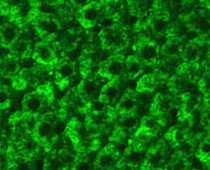ARG41477
anti-Factor IX antibody
anti-Factor IX antibody for ICC/IF,Western blot and Human,Mouse,Rat
Overview
| Product Description | Rabbit Polyclonal antibody recognizes Factor IX |
|---|---|
| Tested Reactivity | Hu, Ms, Rat |
| Tested Application | ICC/IF, WB |
| Host | Rabbit |
| Clonality | Polyclonal |
| Isotype | IgG |
| Target Name | Factor IX |
| Antigen Species | Human |
| Immunogen | Recombinant fusion protein corresponding to aa. 29-192 of Human Factor IX (NP_000124.1). |
| Conjugation | Un-conjugated |
| Alternate Names | Coagulation factor IX; HEMB; FIX; PTC; Plasma thromboplastin component; F9 p22; THPH8; EC 3.4.21.22; P19; Christmas factor |
Application Instructions
| Application Suggestion |
|
||||||
|---|---|---|---|---|---|---|---|
| Application Note | * The dilutions indicate recommended starting dilutions and the optimal dilutions or concentrations should be determined by the scientist. | ||||||
| Positive Control | HT-29 | ||||||
| Observed Size | ~ 47 kDa |
Properties
| Form | Liquid |
|---|---|
| Purification | Affinity purified. |
| Buffer | PBS (pH 7.3), 0.02% Sodium azide and 50% Glycerol. |
| Preservative | 0.02% Sodium azide |
| Stabilizer | 50% Glycerol |
| Storage Instruction | For continuous use, store undiluted antibody at 2-8°C for up to a week. For long-term storage, aliquot and store at -20°C. Storage in frost free freezers is not recommended. Avoid repeated freeze/thaw cycles. Suggest spin the vial prior to opening. The antibody solution should be gently mixed before use. |
| Note | For laboratory research only, not for drug, diagnostic or other use. |
Bioinformation
| Database Links | |
|---|---|
| Gene Symbol | F9 |
| Gene Full Name | coagulation factor IX |
| Background | This gene encodes vitamin K-dependent coagulation factor IX that circulates in the blood as an inactive zymogen. This factor is converted to an active form by factor XIa, which excises the activation peptide and thus generates a heavy chain and a light chain held together by one or more disulfide bonds. The role of this activated factor IX in the blood coagulation cascade is to activate factor X to its active form through interactions with Ca+2 ions, membrane phospholipids, and factor VIII. Alterations of this gene, including point mutations, insertions and deletions, cause factor IX deficiency, which is a recessive X-linked disorder, also called hemophilia B or Christmas disease. Alternative splicing results in multiple transcript variants encoding different isoforms that may undergo similar proteolytic processing. [provided by RefSeq, Sep 2015] |
| Function | Factor IX is a vitamin K-dependent plasma protein that participates in the intrinsic pathway of blood coagulation by converting factor X to its active form in the presence of Ca(2+) ions, phospholipids, and factor VIIIa. [UniProt] |
| Cellular Localization | Secreted. [UniProt] |
| Calculated MW | 52 kDa |
| PTM | Activated by factor XIa, which excises the activation peptide (PubMed:9169594, PubMed:1730085). The propeptide can also be removed by snake venom protease (PubMed:20004170, PubMed:20080729). The iron and 2-oxoglutarate dependent 3-hydroxylation of aspartate and asparagine is (R) stereospecific within EGF domains. Predominantly O-glucosylated at Ser-99 by POGLUT1 in vitro. Xylosylation at this site is minor. [UniProt] |
Images (2) Click the Picture to Zoom In







